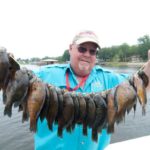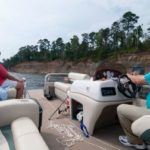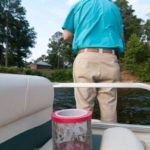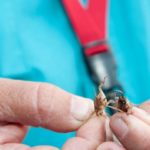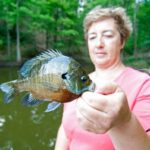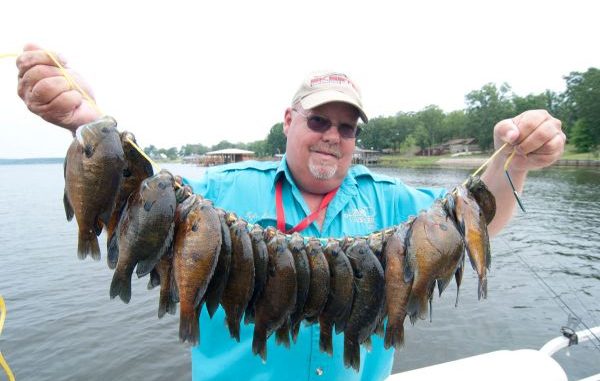
You might think crickets and bobbers are absolutely necessary when fishing for bream. However, this couple has modified a popular bass-fishing technique to load their pontoon boat with fat Toledo Bend bream.
The day started out, well, rough. I hadn’t slept well at all, and then I lost an altercation with a coffee cup. I was left teary-eyed as the hot liquid dripped out of my close-cropped hair and down my face.
I glanced around sheepishly, hoping no one had seen me make an absolute mess. Only the fact that the coffee was hot but not piping hot saved me from serious injury.
So when I finally got things cleaned up, more-carefully fixed another cup of coffee and walked out of Toledo Tackle, I wasn’t digging the upcoming trip.
And then I saw what I’d be fishing out of: A massive pontoon boat sat parked in the lot, and the owner was walking up to me with his hand stuck out.
I shook Lyle Soileau’s hand, but was really groaning inwardly about the boat. Yeah, I know, lots of fish are caught from the danged things, but let’s just say I always viewed those things more as platforms to hang out with friends than to fish from.
Oh, sure, I smiled and looked like I was ready – but my dread of the day on the water was ramping up.
The only saving grace was that I had made the four-hour drive up to fish for bream. As I’ve aged, I’ve redeveloped the joy of snatching one panfish after another out of the water, and I knew the Bend held some big specimens.
I had been putting the hurt on some South Louisiana bream with crickets dangled beneath corks on short ultralights. So I told Soileau I had all the gear necessary to commit mass murder on some slabs.
“You can bring it if you want, but you really don’t have to,” he said. “You can use my gear.
“We’re not using corks, anyway.”
What? No corks? That’s like eating Oreos without the filling. Like ice cream without any sugar. Like coffee without caffeine. Like vegetarian hamburgers.
But the concept intrigued me. So I just shrugged, carefully grabbed my coffee cup (hey, I didn’t want it to puke on me again) and pulled my truck in behind Soileau’s rig.
Thirty minutes later, we were heading out of the launch in the pontoon boat, chatting as we headed across to the Texas side of the lake.
Soileau’s wife, Lynn, sat comfortably watching the water pass by.
As we broke out onto the main lake, high-powered bass boats could be seen ripping across the water. It was the second day of the Bassmaster Elite Series event, and pros from around the country were racing to their starting points for the day.
And we were just easing along.
I had to admit, it was pretty nice not having to hang on for dear life.
By the time Soileau pulled off the gas, I felt like I had known him my entire life. Lynn was a bit more of an anomaly, being a bit quiet like my wife.
But she hopped up as Soileau eased the boat into position, and deftly put the anchor in the water on command. This apparently wasn’t her first rodeo.
And then the tackle was pulled out. Man, it looked like we were going to be catfishing instead of bream.
The rods were long, measuring 6 1/2 feet. Tucked into the reel seats were spinning reels that seemed far too large for the task at hand.
Dangling from the end of the line was a lead egg weight that felt like it weighed a full ounce. About 6 or 8 inches up the line was tied a hook.
Yep, it was a classic drop shot, but it was rigged out with 6-pound fluorocarbon.
“It’s clear and quite a bit stronger (than mono),” he said.
The only thing that seemed right about the rig was that we were using crickets.
“We take 300 crickets,” he said. “We’ll come back with about 50.”
But I still couldn’t picture how we were going to even know when a bream was on the line.
Lynn just smiled slightly, while her husband explained.
“You watch your line,” Soileau said.
While I was accustomed to pitching crickets to cypress trees, Soileau was set up off the bank with just a few stickups visible. The fish had been bedded up in this stretch of water on his last trip, which meant a quick box full of fish.
“We caught 90 without moving,” he said.
Now that’s the kind of fishing that would make up for the hinky start to the day.
As I grabbed a cricket to thread onto the hook, Soileau told me one of his secrets.
“You’ve got to use two crickets; that’s the ticket,” he said. “The bigger the meal, the bigger the fish.
“The little ones can nibble it, but usually before they can get it a bigger one will come and take it from them.”
As we cast out, Soileau explained why he prefers using a drop shot over the tried-and-true cork rig.
“A cork, when it comes through the water, it makes a noise when it comes through the bed, and all the fish will leave,” he said. “With the drop-shot, there’s a bunch of fish on the bed, and when you hook one the other fish will follow it — and then they go right back to the bed.”
Soileau’s line shot to the side, and he set the hook. A nice bream was soon being unhooked and tossed into the ice chest.
“You’ll feel a peck, and then they’ll run off with it,” he explained.
Interesting.
And then my line twitched and moved to the side. I felt almost nothing, and missed the hookset.
But I knew what to expect now, and the next time my line moved to the side I didn’t wait so long and was battling another bream to the boat.
The technique is pretty straightforward: We just cast out to the bed, and then worked the drop-shot rig back toward the boat. When a snag on the bottom stopped the weight, jiggling the line would make the wad of crickets dance enticingly.
Soileau tested out the rig one day while the couple were fishing for white perch, and it as an immediate success.
“He was fishing a drop shot and I wasn’t, and he was catching fish and I wasn’t,” Lynn said.
It’s hard to argue with success, and when they tried it out on bream they found it just as effective.
While every few casts on this morning produced a bite, the action was far from what Soileau expected. So he called for the anchor to be pulled, and we pushed farther back into the cove to another bedding area.
As we idled into position, Soileau said the 3/16-ounce weight at the end of the line is simply a matter of enabling longer casts.
“You don’t want to get too close,” he said. “A lot of people will run right on top of them; they’ll catch 10, 12, 15 fish, but they’ll run off 100.
“Once you run them off, it’ll take an hour, 1 1/2 hours for them to come back.”
He said the weighty hook also helps when wind gusts make bream fishing difficult.
“I can feel the bite better,” Soileau said. “In that wind, I can keep the line tight.”
The fish were there, but even more importantly, the water was calm and clear enough for Soileau to explain what he looks for.
“You’ll see the beds,” he said. “You can see the chicken pocks, the little holes, on the bottom. You can’t see the fish because they’re black, but where you see the chicken pocks you know there’s a bed.”
The bottom of the lake looked like the moon, so there, and bream were scattered around the little holes. And that’s why he was here.
“You want to get in those holes — that’s where the eggs are,” Soileau said. “The fish will come and look at that weight when it comes through the bed, and then they’ll see the cricket.”
The angler said he never spends too much time waiting on fish to bite.
“If you don’t catch one in four casts, we’ve got to go,” Soileau said. “Either they’re there or they’re not.”
Fish after fish came aboard, even though it was apparent the spawn might be over.
“There were a lot more fish here, and they were bigger,” Soileau said.
But there was plenty of action to build a nice stringer of fish.
And as I drove away later that morning, I already was conspiring to try the rig out in my favorite South Louisiana bream holes.
